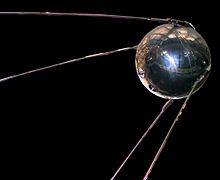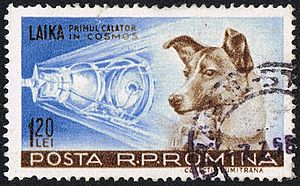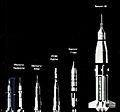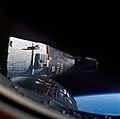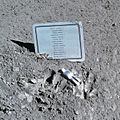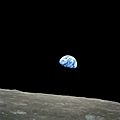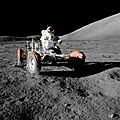Space Race facts for kids
The Space Race was a big competition between the Soviet Union (a country that no longer exists) and the United States. It was all about who could explore outer space first and better. This race lasted from 1957 to 1969.
Both countries wanted to be the first to launch satellites, send humans into space, and land them on the Moon. The name "Space Race" came from the idea of an "arms race," which was a competition to build the most powerful weapons. The Space Race became a very important part of the rivalry between the US and the Soviet Union during the Cold War. Space technology was especially important because it could also be used for military purposes.
The Space Race began when the Soviet Union launched Sputnik 1 on October 4, 1957. It sped up when the USSR sent the first human, Yuri Gagarin, into space. He orbited Earth in Vostok 1 on April 12, 1961. The Soviets achieved many other "firsts" in space over the next few years.
Gagarin's flight made US president John F. Kennedy set an even bigger goal. On May 25, 1961, he asked the US Congress to promise to "land a man on the Moon and return him safely to the Earth" before 1970. Both countries started building huge rockets. The US successfully built the Saturn V, which was big enough to send three people in orbit and two people to land on the Moon.
Kennedy's Moon landing goal was achieved in July 1969 with the flight of Apollo 11. Many people believe that Apollo 11 ended the Space Race with an American victory. Some historians disagree with this idea. Space historian Asif A. Siddiqi suggested a more balanced view.
The USSR continued its plans to land people on the Moon with its N1 rocket. However, they did not succeed and eventually stopped this project. Instead, they focused on the Salyut program, which was the first space station program. They also achieved the first landings on Venus and on Mars. Meanwhile, the US landed five more Apollo crews on the Moon. They also continued to explore other planets and moons using robots.
A period of less tension, called détente, followed. In April 1972, the US and the Soviet Union agreed to work together on the Apollo–Soyuz Test Project (ASTP). In July 1975, a US astronaut crew met a Soviet cosmonaut crew in Earth orbit. They also worked together to create a standard way for spacecraft to connect. This project is often seen as the final act of the Space Race. The competition slowly turned into cooperation.
The collapse of the Soviet Union in 1991 finally allowed the US and the new country of Russia to end their Cold War competition in space. In 1993, they agreed to the Shuttle–Mir and International Space Station programs.
Contents
First Satellite in Space
On October 4, 1957, the Soviet Union launched Sputnik 1. It was the first artificial satellite to go into Earth's orbit. This event officially started the Space Race.
First Animals in Space
Both the US and the USSR sent animals into space. They wanted to make sure it was safe before sending humans. The USSR used dogs for these missions. The US used monkeys and apes.
The first mammal in space was Albert II. He was a rhesus monkey launched by the US on June 14, 1949. His flight was sub-orbital, meaning he went into space but did not orbit Earth. Sadly, he died when his parachute failed during landing.
The USSR sent the dog Laika into orbit on Sputnik 2 on November 3, 1957. Her flight was planned to last ten days. However, the Soviets did not have the technology to bring Laika back safely. The government first reported that Laika died when her oxygen ran out. But in October 2002, the real cause of her death was revealed. She died from stress and overheating on her fourth orbit. This was due to a problem with the air conditioning system. In 1998, a Soviet scientist named Oleg Gazenko said he regretted Laika's death. He felt they did not learn enough from the mission to justify it.
On August 19, 1960, two dogs named Belka and Strelka were sent into orbit. They flew aboard Sputnik 5 and returned safely to Earth.
The Americans sent a chimpanzee named Ham on a suborbital flight. He flew in a Mercury capsule on Mercury-Redstone 2. Ham was recovered safely on January 31, 1961.
Another chimpanzee, Enos, was launched on Mercury-Atlas 5 on November 29, 1961. His flight was supposed to be three orbits long. But the mission was cut short after two orbits. This was because the capsule was overheating. Also, a test that gave him electric shocks was not working correctly.
First Human in Orbit
A major goal in the Space Race was to put the first human into space. The Soviet Union won this part of the race. Major Yuri Gagarin orbited the Earth on April 12, 1961.
Gagarin became a national hero in the Soviet Union and other communist countries. He was also famous around the world. Huge celebrations took place in Moscow and other Soviet cities. These were almost as big as the World War II Victory Parade of 1945. April 12 was named Cosmonautics Day in the USSR. Today, Russia still celebrates it as an official holiday. In 2011, the United Nations declared it the International Day of Human Space Flight.
First Humans on the Moon
On May 25, 1961, President John F. Kennedy of the United States gave a speech to Congress. He set a very difficult goal: to land a man on the Moon by the end of the decade. This was also a challenge to the Soviets to try to do it first.
The Americans won this part of the race in 1969. Neil Armstrong and Buzz Aldrin landed on the Moon and returned safely to Earth.
First Women in Space
The first woman in space was from the Soviet Union. Her name was Valentina Tereshkova. NASA, the US space agency, did not accept female astronauts until 1978. That year, six women were chosen as mission specialists. One of them was scientist Sally Ride. She became America's first woman in space on STS-7 in June 1983.
NASA continued to include women in their astronaut classes. They started accepting female pilots in 1990. Eileen Collins from this group became the first woman to pilot a Space Shuttle flight. This was STS-63 in February 1995. She also became the first female commander of a spaceflight on STS-93 in July 1999.
The USSR accepted its first female test pilot as a cosmonaut, Svetlana Savitskaya, in 1980. She became the first woman to fly in space since Tereshkova. This was on Salyut 7 in December 1981.
First Modular Space Station
The USSR then focused its space program on building a space station. This was the Mir (meaning peace or world) station. It was put together in orbit from 1986 to 1996. Mir weighed about 129,700 kilograms (285,940 pounds). It held records for being the largest spacecraft and having humans live on it continuously for the longest time (3,644 days). This record was later broken by the International Space Station, which started being built in 1998.
Mir's operations continued even after the USSR's space program became the Russian Federal Space Agency in 1991. It was supported by Soyuz spacecraft until 2001.
Images for kids
-
Wernher von Braun became the United States' lead rocket engineer during the 1950s and 1960s.
-
The US rockets for Explorer 1, Mercury, Gemini, and Apollo were a mix of military missiles and the NASA-developed Saturn IB rocket.
-
William Hayward Pickering, James Van Allen, and Wernher von Braun show a full-size model of Explorer 1 at a news conference after the satellite was in orbit.
-
Alan Shepard, the first American in space, 1961.
-
John Glenn, the first American in orbit, 1962.
-
Soviet LK (Lunniy Korabl) and American Apollo Lunar Module lunar landers.
-
A special plaque and the Fallen Astronaut sculpture left on the Moon in 1971. It was left by the crew of Apollo 15 to remember 14 astronauts and cosmonauts who had died.
-
Earthrise, as seen from Apollo 8, December 24, 1968 (photograph by astronaut William Anders).
-
Neil Armstrong, first person to walk on the Moon, 1969.
-
Eugene Cernan drives the Lunar Roving Vehicle during Apollo 17, December 1972.
-
Apollo-Soyuz crew: From left to right: Donald "Deke" Slayton, Thomas Patten Stafford, Vance Brand, Alexei Leonov, and Valeri Kubasov.
-
Space Shuttle (US) docked to Mir (USSR/Russia) (1995). Both were products of the ending competition, joined in the Shuttle-Mir program (1993–1998) which helped create the ongoing International Space Station programme.
See also
 In Spanish: Carrera espacial para niños
In Spanish: Carrera espacial para niños


